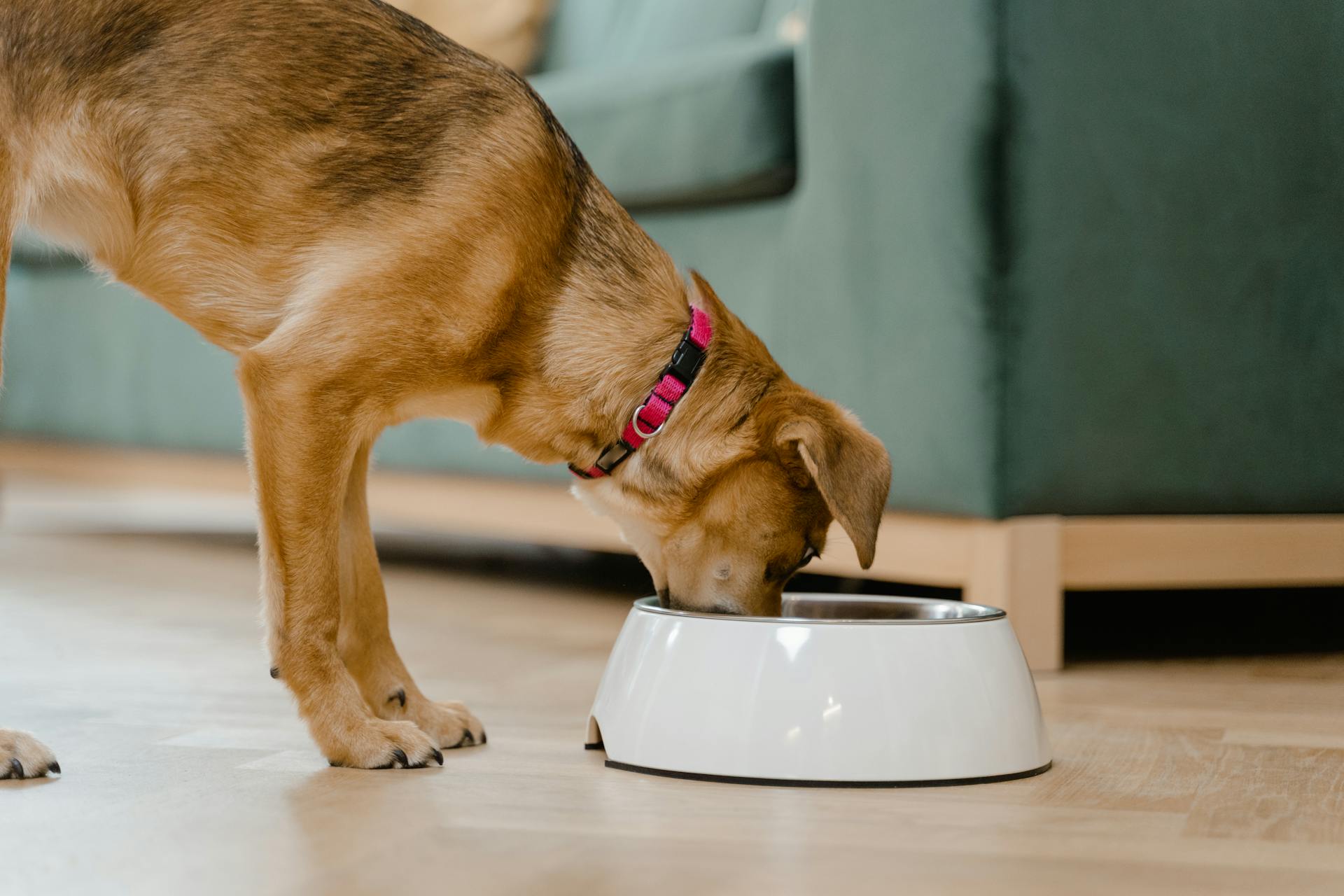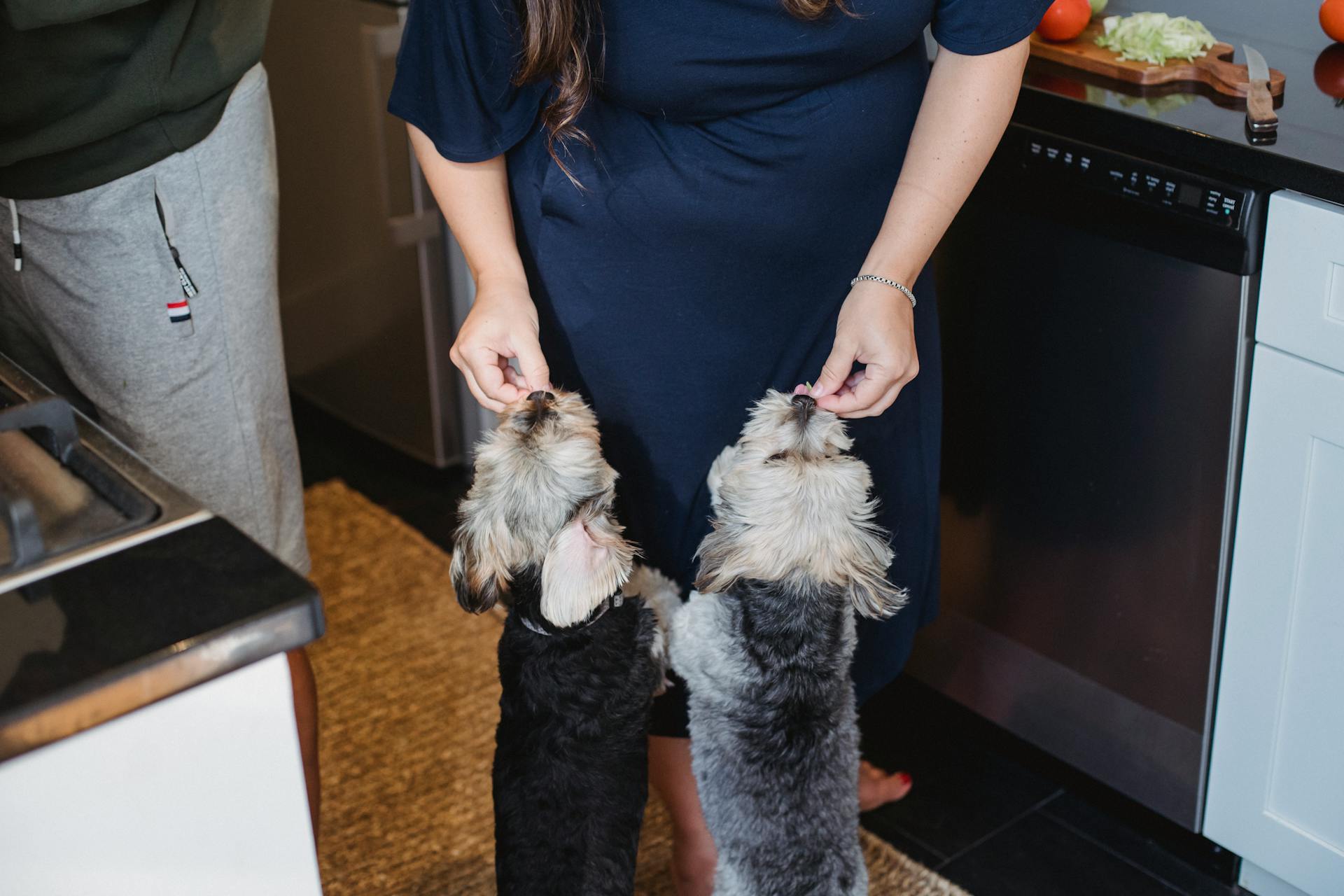
Starting a real food diet for your dog can be a game-changer for their health and well-being.
The key to a successful real food diet is to focus on whole foods, not processed kibble or treats. This means incorporating a variety of fresh meats, fruits, and vegetables into their meals.
A well-planned real food diet can help prevent chronic health issues in dogs, such as allergies, digestive problems, and obesity. By feeding your dog whole foods, you can also promote healthy digestion and a strong immune system.
Some great starting points for a real food diet include incorporating bone broth, which is rich in protein and essential minerals, and adding healthy fats like coconut oil to their meals.
Consider reading: Real Dog Names
Proteins and Ingredients
Proteins play a crucial role in a dog's diet, but it's not just about loading up on protein-rich foods. A healthy balance of protein, carbohydrates, and veggies is essential, and the ideal ratio can vary between dogs.
Here's an interesting read: Is High Protein Dog Food Good for Dogs
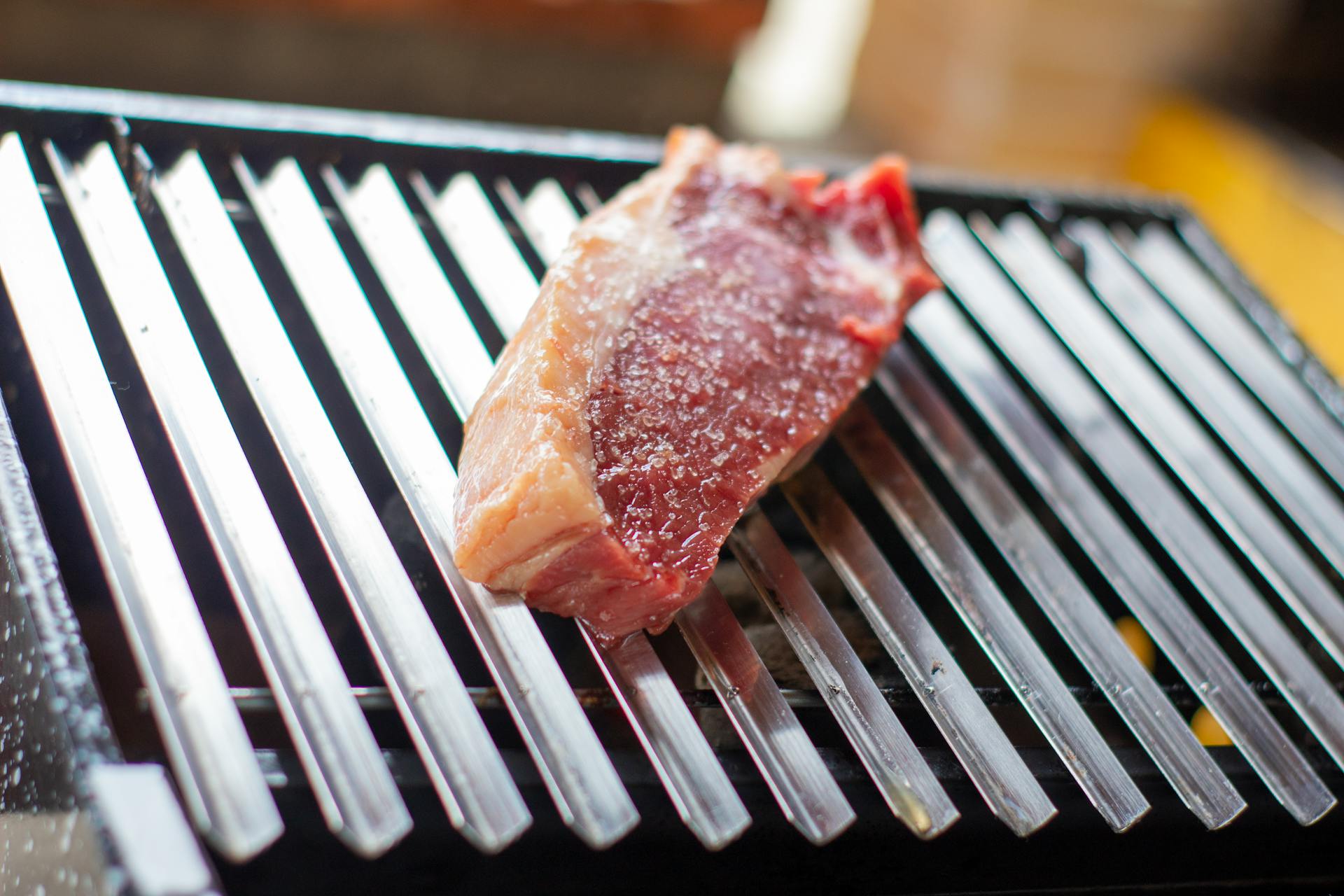
Dogs need a balance of 40% protein, 50% vegetables, and 10% starch, but some dogs may not be able to handle high amounts of protein. It's essential to consult with your vet to determine the best ratio for your furry friend.
You can choose high-quality ingredients for your dog's food, such as whole foods you'd eat yourself, and have control over where the food is sourced. This means you can avoid food recalls and create a nutritionally balanced diet for your dog.
Here's a breakdown of the ingredients you can use in a homemade dog food recipe:
- Ground organic turkey thigh (boneless)
- Ground organic turkey organ meat (liver, gizzards, hearts)
- Finely grated organic veggies
- Ground raw sunflower seeds
- Organic coconut oil
- Salmon oil
- Calcium Citrate (essential for bone health)
Remember to adjust the ingredient measurements based on your dog's weight and activity level, as their caloric needs can quadruple with intense exercise.
Protein Sources
When it comes to protein sources for your dog, there are several options to consider. Dogs are like us, though, in that they need a healthy balance of protein, carbohydrates and veggies.

A good recommendation is to aim for 40% protein in your dog's diet. Some dogs cannot handle high amounts of protein, though, so it's essential to visit your vet to determine the best ratio to suit their dietary needs.
Ground organic turkey thigh is a great source of protein for your dog. You can also add ground organic turkey organ meat, such as liver, gizzards, and hearts, to provide additional protein and essential nutrients.
Here's a quick rundown of protein sources mentioned in the article:
It's worth noting that the recommended amount of protein can vary depending on your dog's weight and activity level. Be sure to adjust ingredient measurements accordingly to ensure your dog is getting the right amount of protein for their needs.
Fruits
Fruits are an excellent source of protein and can be a great addition to a balanced diet. In fact, a medium-sized banana provides about 1.3 grams of protein.

Some fruits, like avocados, are often overlooked as a protein source, but a single medium-sized avocado contains about 4 grams of protein.
Oranges are a good source of protein, but also high in sugar, so moderation is key. A medium-sized orange contains about 0.9 grams of protein.
Fruits like apples and berries are low in protein, but high in fiber and antioxidants, making them a great addition to a healthy diet.
Incorporating fruits into your diet can be as simple as adding them to your breakfast oatmeal or yogurt.
Recommended read: Dog Food for High Energy Dogs
Grains
Grains are a type of carbohydrate that come in many forms, including oats, quinoa, and brown rice.
Whole grains like quinoa and brown rice are higher in fiber and nutrients compared to refined grains like white rice.
Oats are a good source of soluble fiber, which can help lower cholesterol levels.
Rye and barley are other examples of whole grains that can be used in baking and cooking.
Whole grains can be more filling due to their higher fiber content, making them a good choice for weight management.
See what others are reading: Is Lamb and Rice Dog Food Good for Dogs
Diet Planning and Preparation
To start preparing a real food diet for your dog, you'll need to get the right equipment. This includes a food scale, food processor, pots, pans, and Tupperware or bags for portioning the food.
Make sure to purchase fresh, high-quality ingredients that are free from seasonings, heavy processing, and canning. This will ensure your dog is getting the nutrients they need.
When cooking, keep your area clear of foods that may be harmful to your dog. Use a food scale to measure out the ingredients accurately, and cook them as directed. Don't forget to mix in any necessary supplements.
To store your homemade dog food, divide it into single servings and place them in a container to store in the freezer or fridge. Be sure to use your food within six months, as it's best to avoid feeding old food to your dog.
A simple table to help you plan your diet:
Remember to find a recipe that's complete and balanced to ensure your dog is getting all the necessary nutrients.
Making the Switch
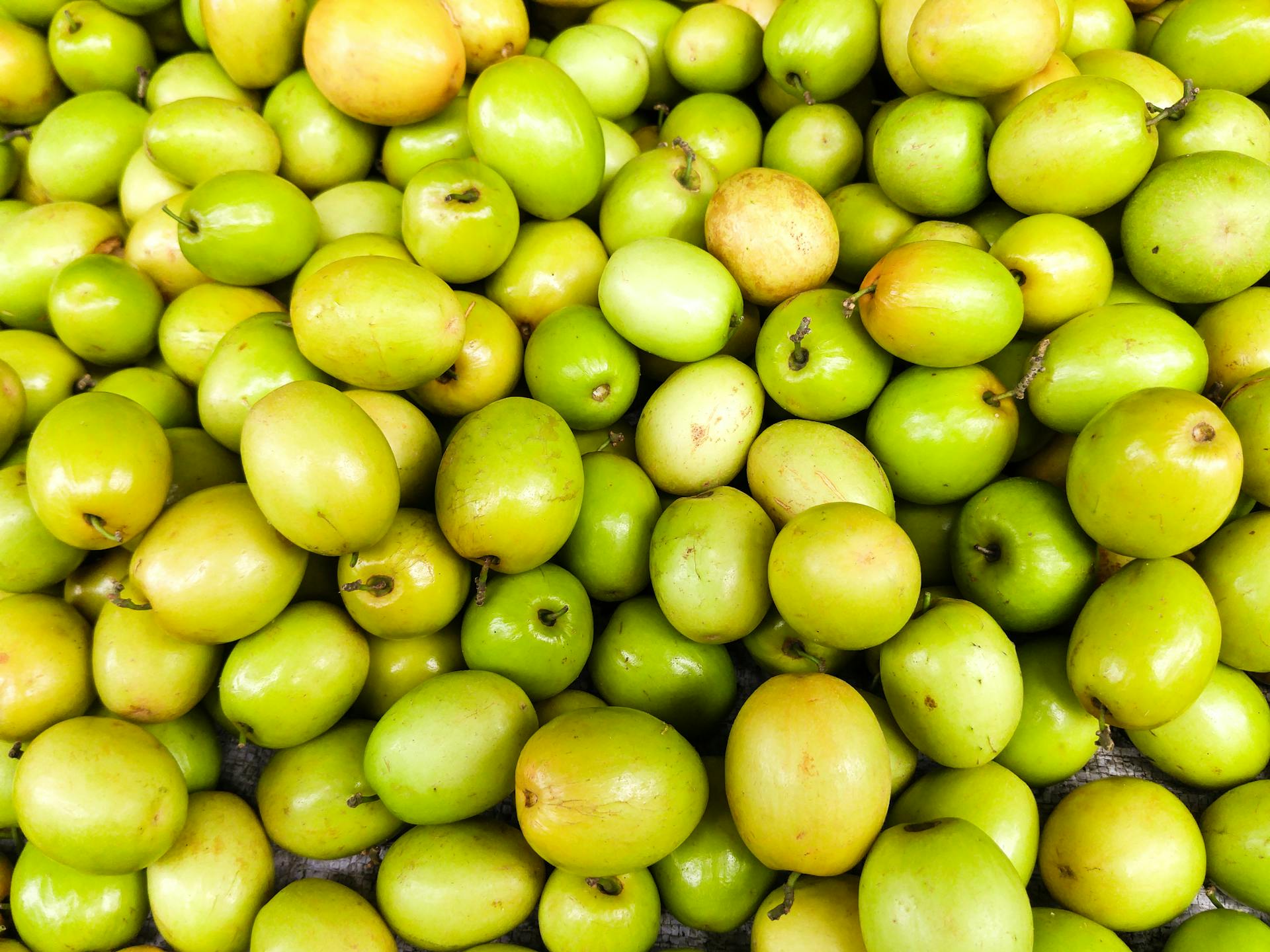
Most dogs can't switch to a home cooked diet overnight, so it's essential to transition them slowly over 6 days to a week.
Day 1 is a great starting point, where you mix 20% of the new food with 80% of the old.
As you move forward, you'll increase the percentage of new food gradually, reaching 100% by Day 6.
Here's a rough guide to follow:
Keep a close eye on your dog's health during this transition, and be prepared to adjust the plan if you notice any digestive issues, such as diarrhea or vomiting.
How to Prepare
To prepare homemade dog food, you'll need a few essential tools and ingredients. A food scale, food processor, pots, pans, and containers or bags for portioning the food are must-haves.
It's crucial to purchase fresh, high-quality ingredients that are not canned, seasoned, or heavily processed. This will ensure your dog gets the nutrients they need.
Suggestion: Do Small Dogs Need Small Breed Food
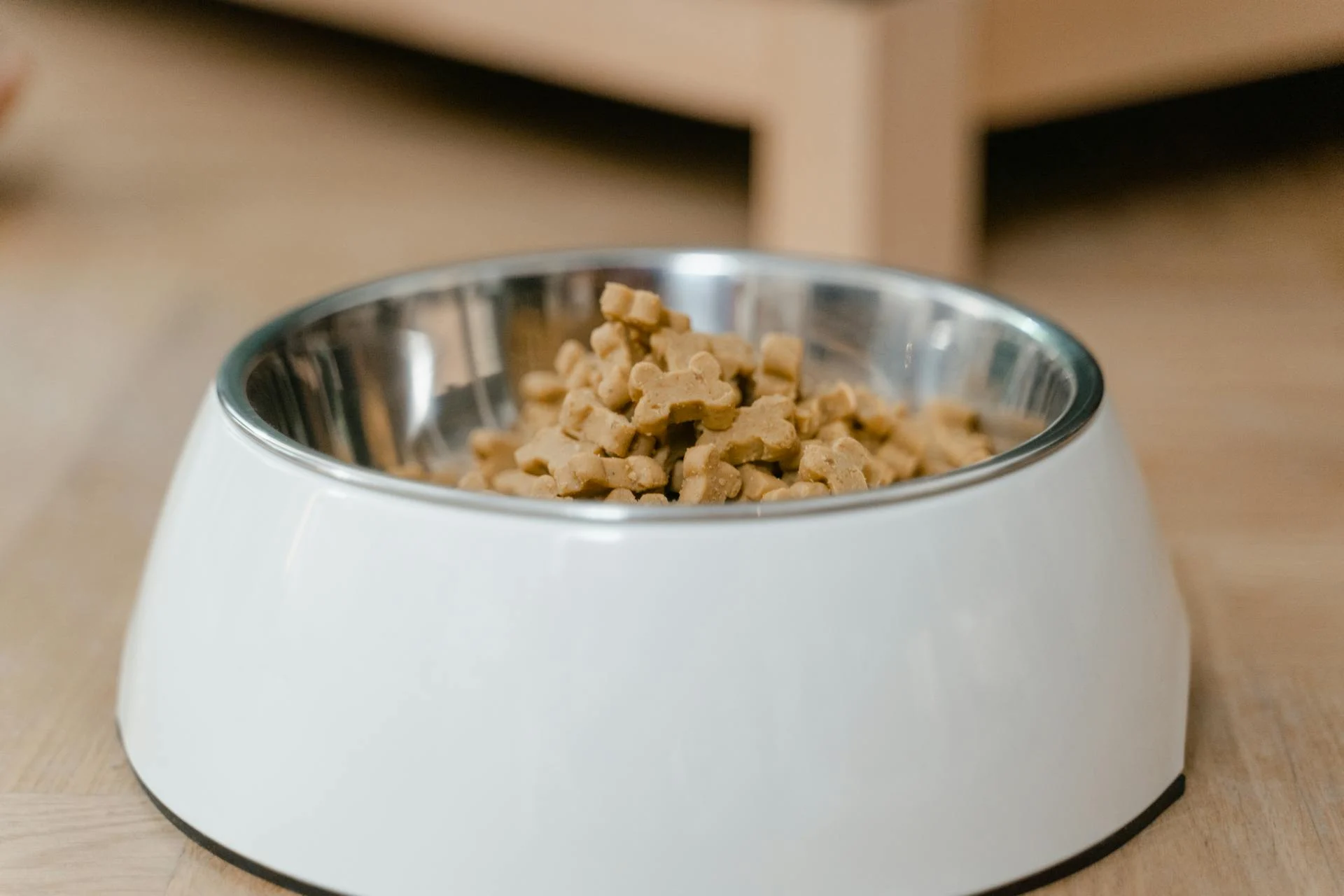
Before you start cooking, set up a clean area of the kitchen that is free of foods that may be harmful to your dog. This will help prevent any accidental ingestion.
When measuring out ingredients, use a food scale if possible for accuracy. This will help you ensure the correct proportions of each ingredient.
Cook the ingredients as directed on the recipe, and mix food and supplements together well, ideally using a food processor to blend ingredients.
To store the homemade dog food, place it in containers and store in the refrigerator or freezer. Refrigerated food will stay fresh for three to four days, while frozen dog food is best within about two months.
Consider reading: Just Food for Dogs Ingredients
Nutrition and Balance
Providing your dog with a balanced diet can be a challenge, but it's essential for their overall health and well-being. Feeding an incomplete or imbalanced diet can lead to vitamin and nutrient deficiencies in dogs.
To ensure your dog gets the nutrients they need, a homemade diet should contain at least 10% protein, such as chicken, turkey, fish, or lean beef, and up to 50% carbohydrates, like rice, pasta, and potatoes. These ingredients provide fiber, which can come from vegetables like peas, green beans, and carrots.
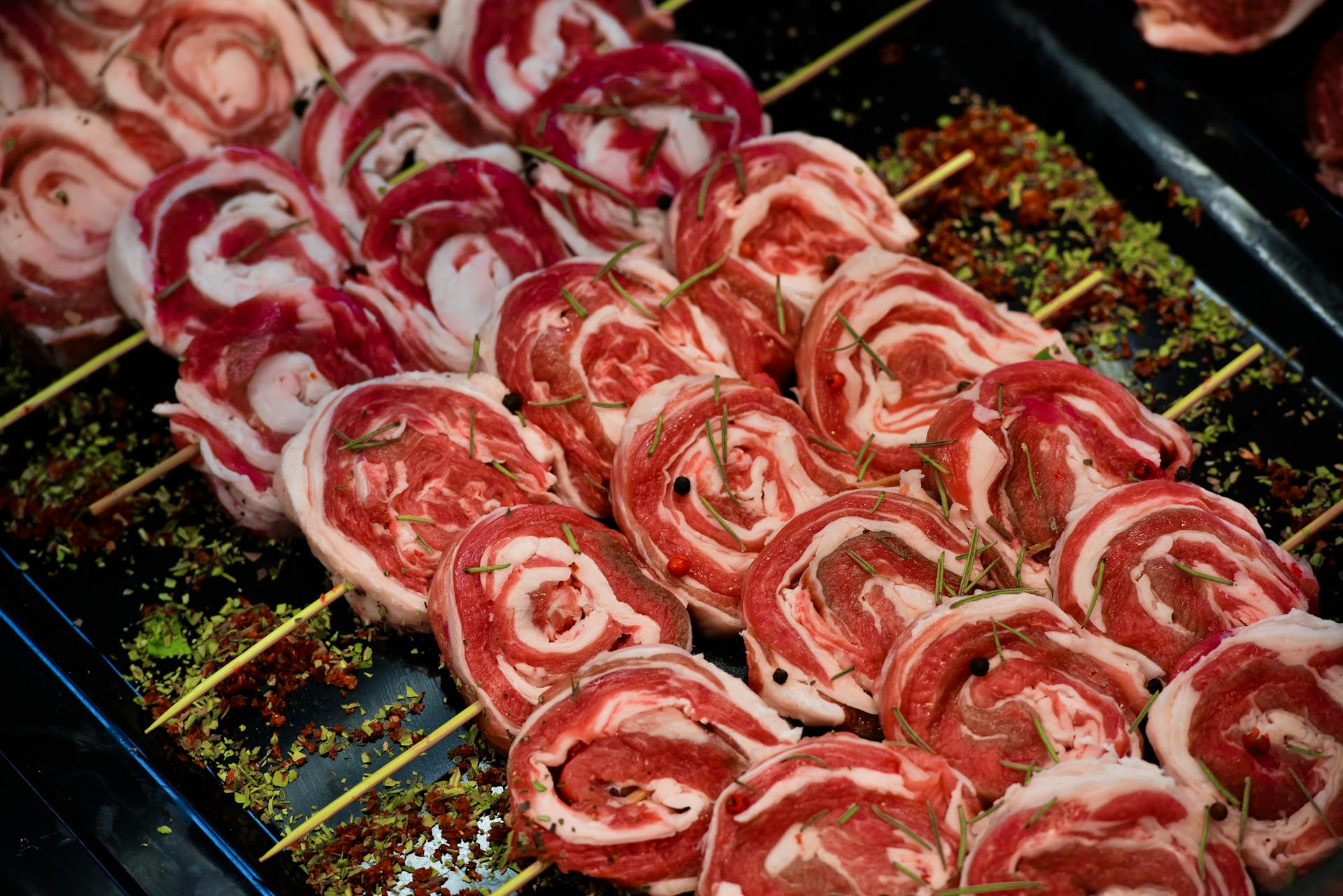
Here's a breakdown of the essential nutrients for a balanced diet:
It's also crucial to add vitamins and minerals to the food to ensure it's complete and balanced. Your veterinarian can help you determine the right supplements for your dog's specific needs.
Vegetables
When feeding your dog a homemade diet, it's essential to include a variety of vegetables to ensure a well-balanced meal.
Sweet potatoes are a great option, rich in fiber and vitamins A and C. They're also easy to digest and can be cooked in a variety of ways.
Carrots are another excellent choice, providing a boost of vitamin A and fiber.
Butternut squash is a nutrient-rich vegetable that's easy to add to your dog's meals, offering a good source of fiber and vitamins A and E.
Spinach is a nutrient-dense leafy green that's packed with iron and vitamins A and K.
Proper Nutrition
Proper Nutrition is key to keeping your furry friend healthy and thriving. Dogs' nutritional needs differ from ours, so you can't just share your dinner with them.
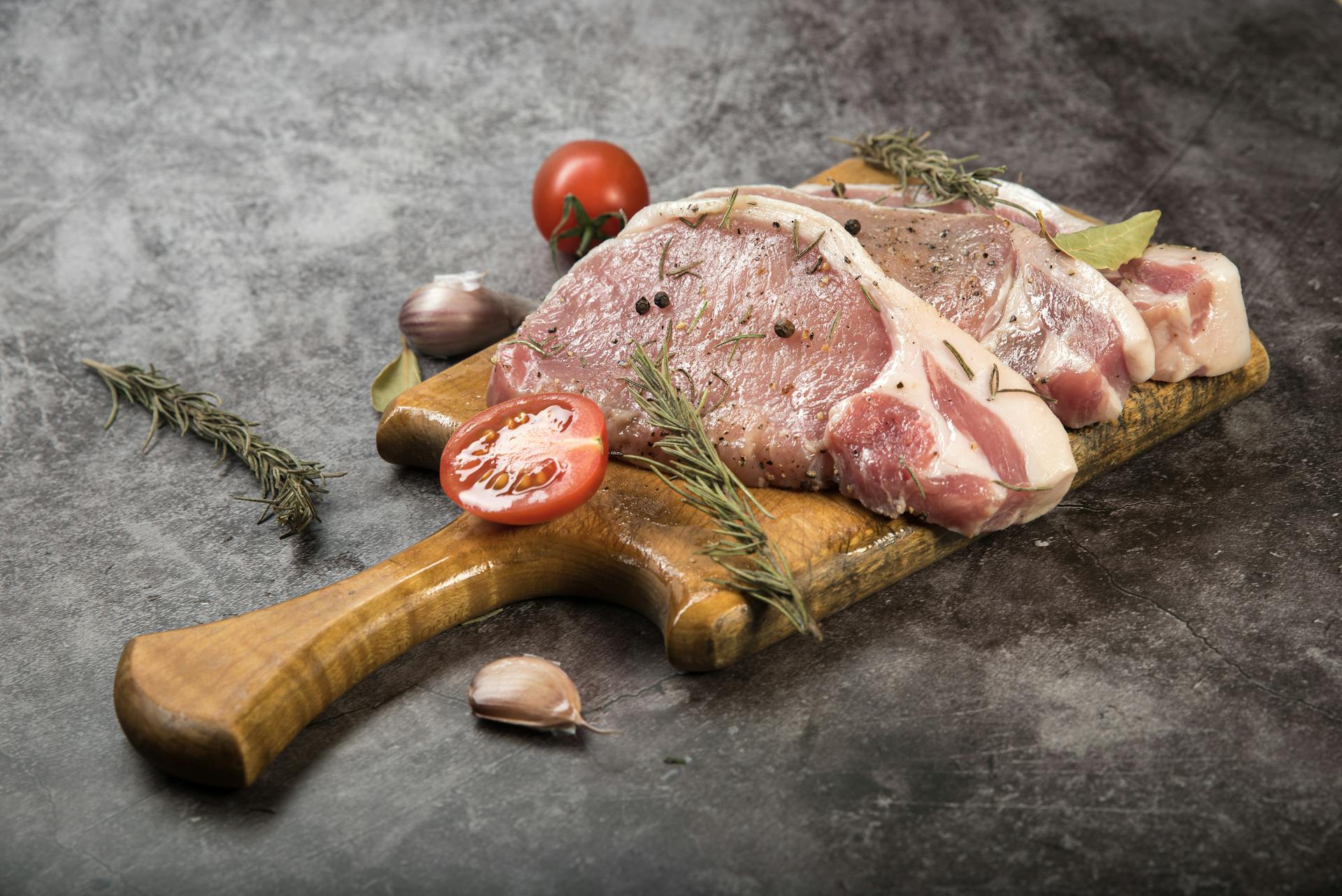
A homemade dog diet should contain an appropriate balance of protein, carbohydrates, fiber, and fat. This balance is crucial to prevent vitamin and nutrient deficiencies. Your veterinarian can help determine your dog's daily caloric needs based on their life stage and activity level.
Protein is essential for your dog's growth and maintenance. Aim for at least 10% protein in your dog's diet, which can come from sources like chicken, turkey, fish, or lean beef.
Carbohydrates provide energy and some fiber, making up to 50% of your dog's diet. Good sources include rice, pasta, and potatoes. Fiber is also important for digestive health, with about 2.5-4.5% coming from vegetables like peas, green beans, and carrots.
Fat is necessary for your dog's overall health, with at least 5.5% coming from sources like vegetable oil. Don't forget to add vitamin and mineral supplements specifically designed for dogs, which can be purchased from reputable companies like BalanceIT.com.
Here's a quick rundown of the essential nutrients for a balanced homemade dog diet:
Consult with your veterinarian to get started on creating a balanced and delicious homemade dog diet.
Ensuring Your Pets' Balanced Diet
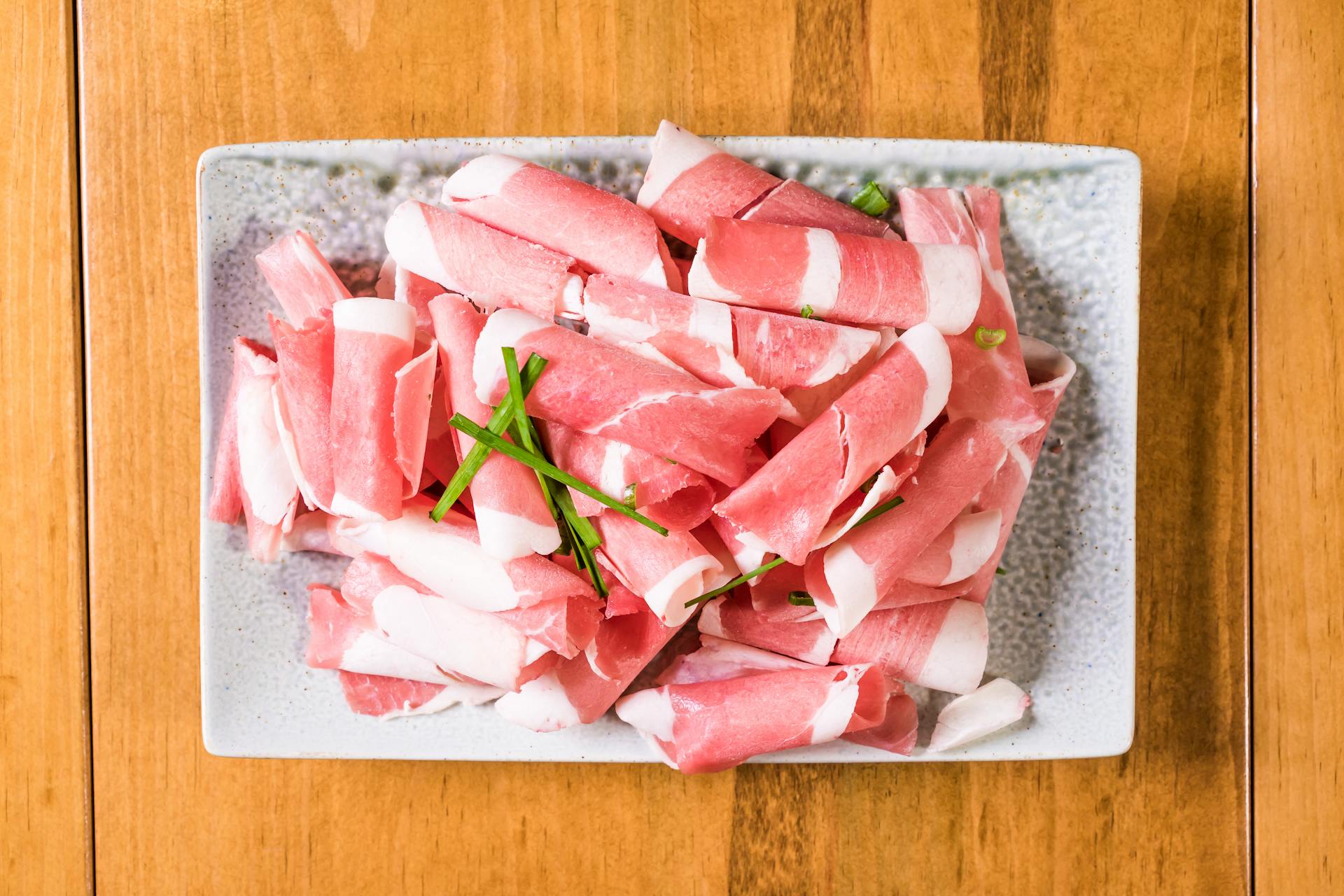
Providing your dog with a homemade diet requires careful planning and attention to detail. It's essential to ensure you have time to prepare the food correctly, as the cooking process involves measuring ingredients and preparing the food properly.
A homemade dog diet should contain an appropriate balance of protein, carbohydrates, fiber, and fat. This means including at least 10% protein, such as chicken or turkey, up to 50% carbohydrates, like rice or pasta, and about 2.5-4.5% fiber from vegetables like peas, green beans, and carrots.
To ensure your dog's diet is complete and balanced, you'll need to add vitamin and mineral supplements specifically designed for dogs. These supplements can be purchased from reputable companies like BalanceIT.com.
Here are the key nutrients your dog's diet should include:
- At least 10% protein
- Up to 50% carbohydrates
- About 2.5-4.5% fiber
- At least 5.5% fat
- Vitamin and mineral supplements
If you're considering a homemade diet for your pet, it's crucial to consult with your veterinarian first. They can help you determine the best diet for your pet based on their life stage, activity level, and any health concerns.
Remember, a homemade diet can be a hassle to make from scratch, but with the right guidance and planning, you can provide your pet with a balanced and nutritious diet that they'll love.
Health and Wellness
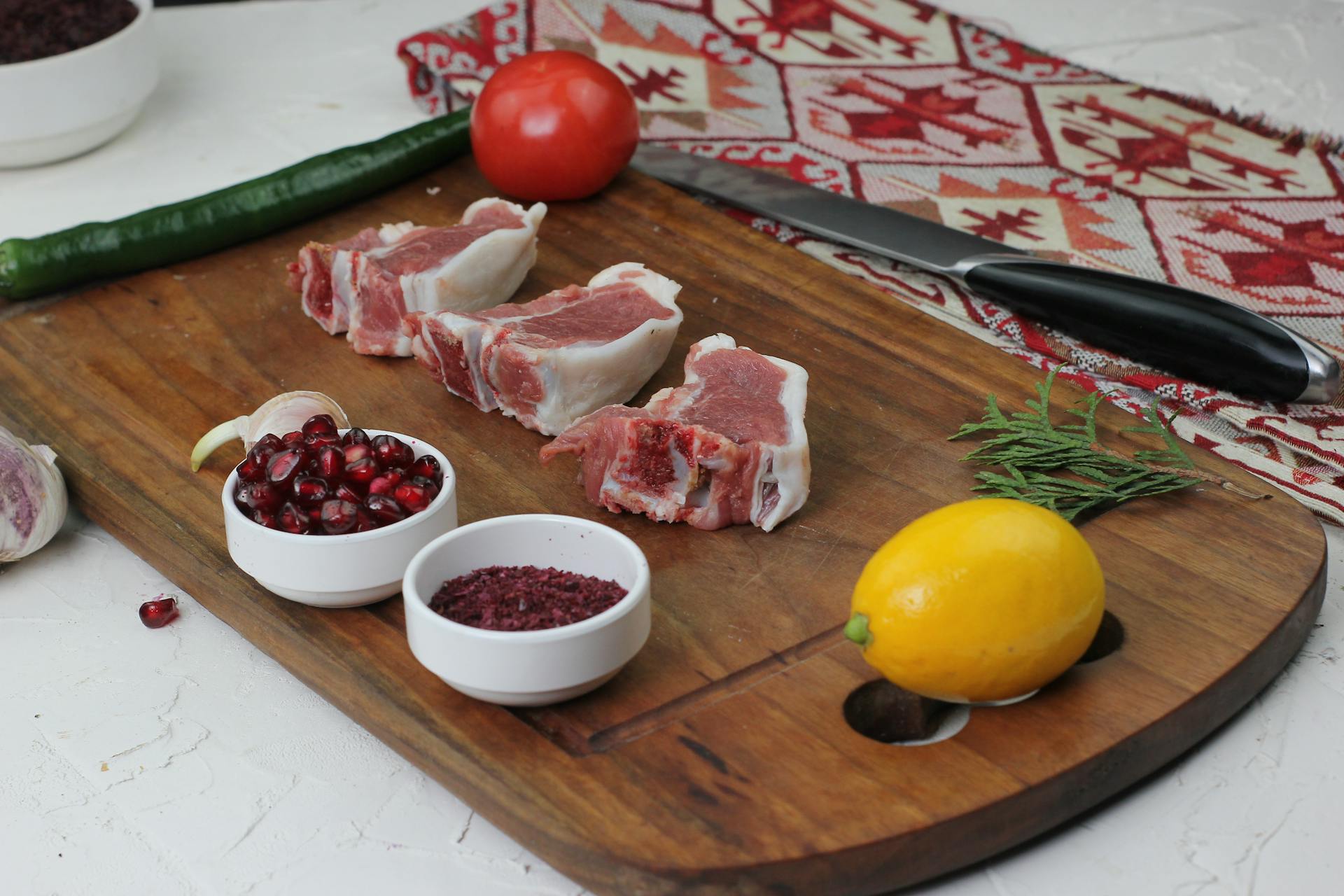
To ensure your dog gets the nutrients it needs, you should consult with your veterinarian about your dog's health needs and consider supplementing with a nutrient mix for homemade dog food. This allows you to tailor your dog's diet to its specific requirements.
Custom-made homemade dog food recipes can accommodate your dog's diet and health concerns, making it easier to ensure your dog gets the nutrients it needs. By adding fresh food ingredients, you can create a nutritionally balanced diet for your dog.
Monitoring your dog closely is crucial when switching to homemade dog food, so keep a record of your dog's weight and body condition over time.
Take a look at this: What Nutrients Do Dogs Need in Homemade Dog Food
Improving Your Health with a Diet
Eating a diet rich in whole food ingredients can be a game-changer for your overall health. Many pet parents who cook homemade dog food for their furry friends are also trying to eat healthier themselves.
Making healthy choices can be contagious, and it's not uncommon for people to want the same for their pets. A homemade diet is preferred because it contains whole food ingredients that are better for your health than processed foods.
Cooking at home allows you to control the ingredients and portion sizes, which can lead to weight management and improved digestion. This is especially true for people who have struggled with digestive issues in the past.
Curious to learn more? Check out: Food Safe for Dogs
Feeding Bones Safety
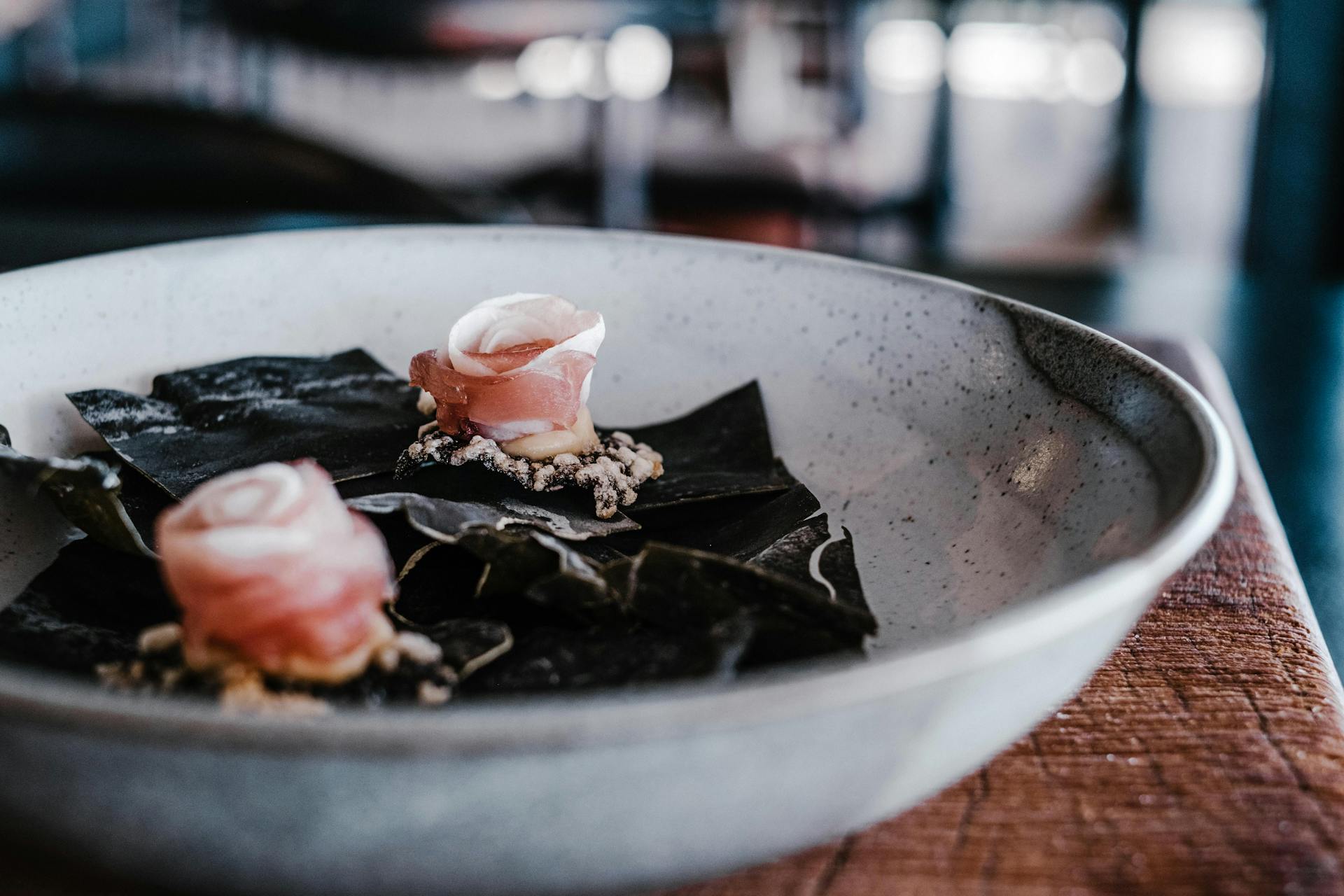
Raw bones are a great option for dogs, as they're pliable and packed with calcium, which is essential for their health. I've seen many dogs enjoy raw bones without any issues.
Cooked bones, on the other hand, can be a problem because they splinter easily and can get lodged in a dog's throat. This is a serious concern that dog owners should be aware of.
Chewing bones is a great way to keep a dog's teeth clean, which can save you from astronomical dental bills in the long run. I've heard many stories of dog owners who've avoided costly dental procedures by simply giving their dogs raw bones to chew on.
Intriguing read: How Much Should a Great Pyrenees Eat
Northwest Holistic Pet Care: 20 Lb
If you're considering a homemade diet for your 20-pound dog, you'll want to ensure the recipe is tailored to your pet's specific needs. This can be done by speaking with your veterinarian about your dog's health needs and supplementing with a nutrient mix for homemade dog food.
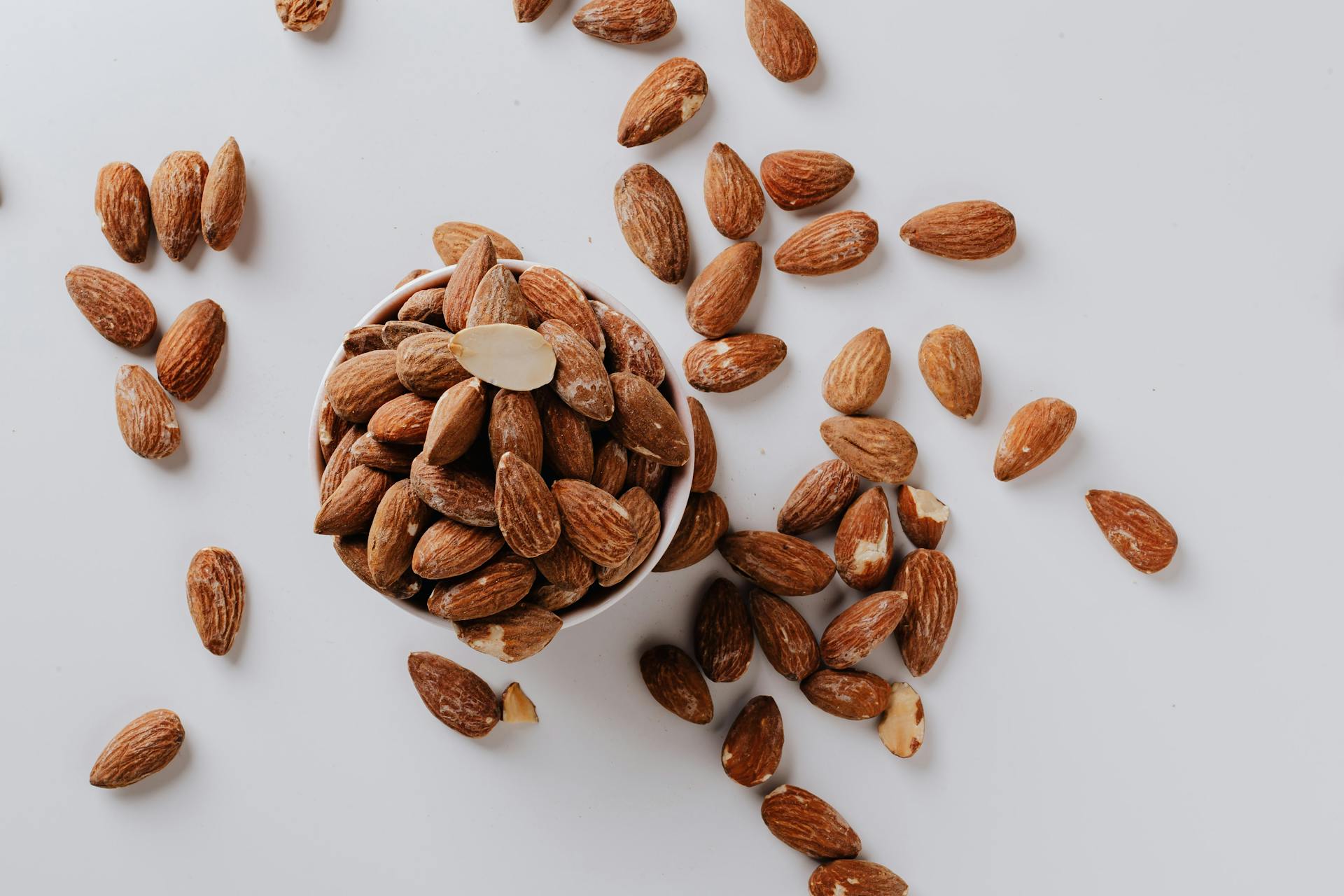
It's essential to remember that homemade meals can be more complicated or time-consuming if your dog has food sensitivities or food allergies. To keep your dog interested in its home-cooked meal, you may need to source a variety of dog recipes and switch up the homemade diet regularly to keep your dog interested.
A good place to start is with a standard base mix for homemade dog food, which can be found in various recipes online. This base mix can then be customized with vitamins and supplements as needed. You'll also want to ensure you can afford the ingredients needed to make your dog's food, as homemade food can be more expensive than kibble.
To minimize the time commitment, consider preparing the home-cooked meal in advance and dividing it into meal portions. This can be especially helpful if you have a busy schedule. You can also store large batches in the freezer for future use.
Here are some nutritional requirements to keep in mind when creating a homemade diet for your 20-pound dog:
Remember to consult with your veterinarian to determine the best nutritional plan for your dog's specific needs.
Frequently Asked Questions
What is the best real food diet for dogs?
A balanced diet for dogs consists of natural ingredients like beef, chicken, lamb, fruits, and vegetables, which can promote overall well-being and improve various health aspects. Consider a diet rich in real foods like these to give your dog the best possible nutrition.
Sources
- https://unionlakeveterinaryhospital.com/blog/a-beginners-guide-to-home-cooking-for-dogs
- https://thekindpet.com/blogs/blog/homemade-dog-food-nutritionally-complete
- https://www.thesprucepets.com/homemade-dog-food-recipes-5200240
- https://wellnessmama.com/natural-home/homemade-dog-food/
- https://sidebysidepet.com/blogs/feed-love-feed-life%E2%84%A2/whole-food-diet-for-dogs-12-foods-to-include
Featured Images: pexels.com
